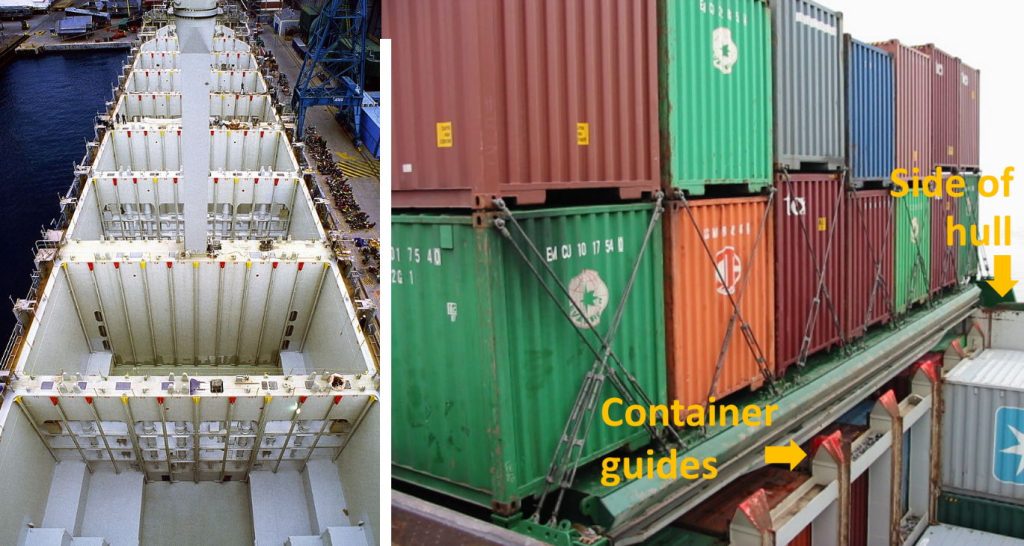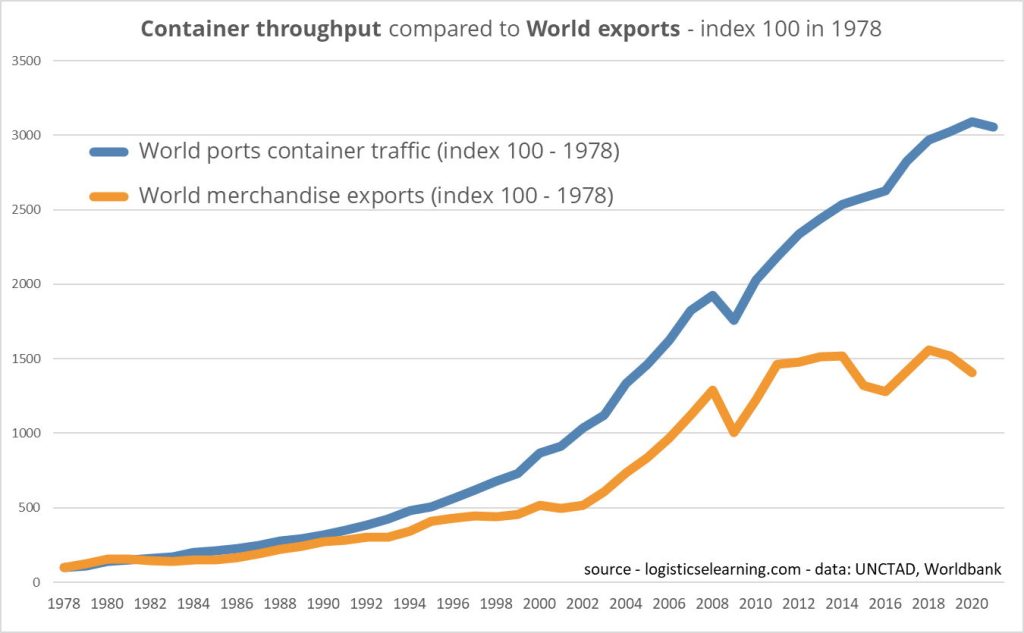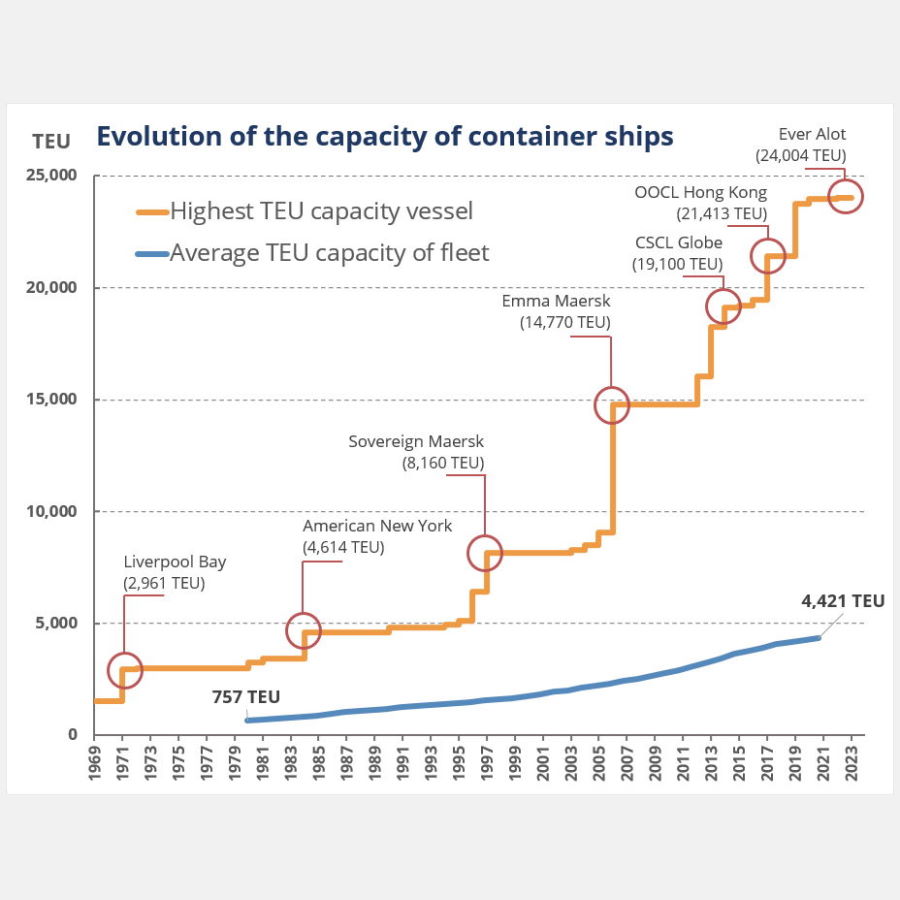In this article, we will look the evolution of container ship since 1955 and at the largest container ships of the last 69+ years.
In 1955, the first container dedicated vessel, the Clifford J.Rodgers, was put into service and was used to deliver cargo containers (non-standard) from railheads in Vancouver and Skagway.
The Clifford J.Rodgers was 102.24 meters long, 14.33 meters wide, carried specifically designed containers of 2.14 meters long (with a container carrying capacity perhaps equivalent to 65-70 TEUs), reached a speed of 11.75 knots, and was operated by a crew of fifteen.
In 1956, the Ideal X, a converted WW2 tanker carried the first standard containers – all 58 of them – from Newark to Houston and become the first commercial container ship using standardized steel containers.
The Ideal X was 160 meters long and 9.1 meters wide and we can estimate its capacity at around 100 TEUs.
In April 2023, MSC Irina completed her maiden voyage from Guangzhou Port in China to Europe.
The MSC Irina is 399.99 meters long, 61.33 meters wide, can carry an astounding 24,346 TEUs, and can stack 25 to 26 containers on top of each others – which means a total height comparable to a 20+ stories building! Cruising at around 15 knots, she is operated by 25 crew members.
But how did the capacity evolve from 100 to over 24,000 TEUs – a capacity of 50 forty feet (40′) containers to one of 12,000 – in just over 65+ years?
The below chart, based on our research and publicly available data, shows the evolution of the capacity of container ships since 1969 (when the model was starting to prove itself and the capacities were starting to grow) to 2022.

Source – logisticselearning.com —– reusable under Creative Commons BY-SA 4.0 intl license
As you can see, there are some key steps, some key jumps, in the evolution of the size of container ships. These are generally linked to the technological evolution of shipbuilding, the changes in infrastructure, such as port sizes or canal widths, and also in function of the development of international trade and the strategies of the major shipping lines. Below, we will present some of these important changes and see how they impacted the size and capacity of container ships.
Exploring the concept – the first generation of container ships
From 1955, with the Clifford J.Rodgers, and 1956, with the more famous Ideal-X, the first generation of container vessels, still competing with the break-bulk shipping lines, were looking to prove the efficiency of container shipping and pioneer this new transportation technology and strategy.
And even if these first generation ships were often converted tankers or bulk carriers, who would carry their containers only on their modified decks and had to be geared (equipped with cranes), as, at the time, ports did not have the proper equipment to offload containers, they still saw their market share grow and their record TEU capacities slowly increased to around 1,500 TEUs towards the end of the 1960s.
To support this growth and profit from this emerging opportunity, the ship and port infrastructure building industries increased their technological development efforts. These efforts paid back with the delivery of the 2 major technological improvements:
- in 1959 – the first container shore crane, which would enable container vessels to rely on port equipment rather than their own cranes, freeing up deck space and enabling less constrained ship designs.
- and even more importantly, from 1968, the development of the fully cellular container ships.

Proving the concept – the second generation of container ships
Until 1968, container ships would carry containers only on their deck, but that year would see the deployment of the first fully cellular (C7 class) container ships, such as the Encounter bay (IMO 6818461, TEU 1,530).
These second generation container ships were able to carry containers in their belly hold, thanks to rails and cells which hold them securely in place while helping their smooth and efficient loading and unloading.
Fully cellular container ships were also designed to sail faster, reaching cruising speeds of 20-24 knots, making them more competitive for the dry, typically manufactured and higher value goods transported in shipping containers when compared to the slowly more energy efficient converted bulk carriers, tankers or their competing break bulk vessels whose cruise speeds would be closer to 16-20 knots.

In the following years, significantly larger, fully cellular vessels were put to sea such as the Liverpool Bay (IMO 7126762, TEU 2,961), in 1971, or the Hamburg Express (IMO 7129934, TEU 2,964), in 1972.
The evolution of these shipbuilding technologies and the success of these larger vessels were the final proof needed that shipping containers and vessels were the way of the future for moving non-bulk cargo.
With this proof of concept secured, ports increased even further their investment and development of container specific terminals and handling equipment, which in turn alleviated any concern in developing and using fully cellular, non-geared, container dedicated vessels.
The adoption of containerization – the third generation of container ships
From its confirmed adoption in the late 1960s, and early 1970s, the amount of shipped containers started to grow in parallel, and at the same rate as the growth of worldwide exported goods. Container shipping lines were holding on to their market share in the international ocean shipping world.
To absorb the increase in the number of containers to be moved and to support the growth of global export, not only did the global fleet grow in number of vessels, but new larger vessels – such as the American New York (IMO 8212611 – TEU 4,614 – built 1984) – were built, as their owners could now be confident that enough containers needing to be moved would be available to maximize their utilization and benefit from a lower per container operating cost.
But with the deployment of American New York, in 1984, the strive to develop ever larger container vessels came close to a standstill and the largest vessels would stay comparable until 1996.
This reticence to pursue the development of larger vessels can be seen as mainly linked to the fact that many major routes and containers would, at the time, transit through the Panama Canal and there was a concern that building vessels wider than the canal would restrict their usage to certain routes, they would be too large to operate efficiently on these limited routes, and their relatively limited demand.
In fact, the width of American New York was 32.20 meters (105.5 ft) with the maximum authorized width of the canal being 32.31 meters (106 ft) at the time.
A few vessels, such as President Truman (IMO 8616283, TEU 4340, built 1988), were built in this period (1984 to 1996) with a width larger than the Panama Canal but their capacities were comparable to the Panamax vessels, therefore confirming that the non-Panama Canal related traffic may not have been considered sufficient to accommodate higher capacity vessels.
The take-off of containerization – Post-Panamax vessels
The increase of international trade (and even more so of the Asia – Europe one) from the mid 1990s, resulted in a dramatic increase of the number of containers needing to be moved, and the development of multiple major shipping routes originating in Asia and more specifically China.
More and more dry goods were being produced in Asia and looking to be shipped to Europe or North America.
Maersk saw this as the opportunity to develop post-Panamax vessels – larger vessels that could not pass through the Panama canal but could perfectly serve the routes from Asia to Europe and from Asia to North America West Coast.
Taking a different approach to the previous focus on the polyvalence of the fleet and no longer considering the width of the Panama canal as the reference width for the largest vessels, Maersk deployed the Regina Maersk (IMO 9085522, TEU 6,418) in 1996 with its width of 42 meters, compared to the canal’s maximum of 32, and the even higher capacity Sovereign Maersk (IMO 9120841, TEU 8,160) in 1997.

Source – logisticselearning.com —– reusable under Creative Commons BY-SA 4.0 intl license
The development of these new vessels, the development of Asia as a major production region, and the resulting surge in dry manufactured goods needing to be transported overseas, resulted, as you can see in the above chart, in an increased rate of growth for the number of moved containers. This growth was now strongly exceeding the one of exported goods – meaning that a higher and higher portion of exports were now relying on containers and container vessels rather than on other means of overseas transport.
Economies of scale – the development of Very Large and Ultra Large Container Vessels
These post-Panamax vessels were a strong contributor to the decrease in transport rates for containers from Asia and helped confirm the Asian region as a major source of international trade which in turn increased the number of containers needing to be moved from and to this region. Based on this, Maersk decided it was once again feasible to increase significantly the size of its largest carriers and target higher economies of scale.
In 2006, the newly built Emma Maersk (IMO 9321483) was the first vessel of their Triple E class and was developed for Maersk with a focus on “Economy of scale, Energy efficiency, and Environmental impact improvement”.
She started operation on the Asia to Europe route and her capacity of 14,770 represented an increase of 80% in capacity compared to the previous record holder.
The Emma Maersk and the Triple E fleet confirmed the leader position of Maersk on the container shipping market and, over the following years, proved that the model of using even larger container vessels to move from major ports to major ports and smaller vessels to feed containers into these ports worked and that economies of scale were possible and real.
The race for the largest container ship
The Triple E vessels, the first Very Large Container Vessels, remained the largest vessels until 2013 when multiple shipping lines actively joined the race for economies of scale.
From 2013 to today, shipping lines (mainly those operating on the Asia-Europe routes) have been breaking records of the largest container vessel and capacity, year after year, with for example:
- CSCL Globe (IMO 9695121) – built 2014 – with a capacity of 19,100 TEUs.
- OOCL Hong Kong (IMO 9776171) – built 2017 – with a capacity of 21,413 TEUs.
- Ever Ace (IMO 9893890) – built 2021 – with a capacity of 23,992 TEUs.
- Ever Alot (IMO 9893955) – built 2022 – with a capacity of 24,004 TEUs.
- MSC Irina (IMO 9929429) – built 2023 – with a capacity of 24,346 TEUs.
The largest container ship to date
Ever Alot is the seventh vessel of the Evergreen A class and, as we saw, the first ship to pass the symbolic bar of 24,000 TEU in capacity. Another 6 ships are planned for this class but their capacity should not break the current record of 24,004 TEUs.
Nevertheless plans to build vessels with capacities over 25,000 TEUs are already in place and it seems the race for economies of scale and the development of Ultra Large Container Vessels is not yet over.
The new Panama Canal locks and the Neo-Panamax vessels
Parallelly to the development of these Ultra Large Container Vessels on the Asia-Europe routes, there have also been significant changes to the Pacific-Atlantic routes.
Indeed in 2016, after a 10 year construction effort, new wider locks were put in place in the Panama Canal, and the newly released limits and requirements allow vessels up to a width of 51.25 m (168 ft) to pass compared to the previous maximum of 32.31 m (106 ft).
The Panama Canal being the key passage for the trade between the Pacific and the Atlantic ocean based ports, this widened capacity resulted in the development of larger container vessels, called New-Panamax or Neo-Panamax for these routes with a capacity of up to 14,000 TEUs (compared to the previous 5,000 TEUs of the Panamax vessels), and while larger vessels were already in operation (notably on the China – Europe route), the development of these New-Panamax vessels had a direct and significant impact on the average TEU capacity of the container vessel fleet.

We hope you enjoyed this article on the evolution of container ship and their sizes.
The data it contains is based on our own research and publicly available information. It is often based on our interpretation of possibly diverging or even contradictory information and therefore may contain incorrect information or certain record-breaking vessels may have been overlooked.
If you spot an issue, feel free to leave a comment with a reference link and we will be happy to fix it.
Our own vessel list data can be found here.
If you want to take this further, you can subscribe to our Ocean freight focused eLearning courses:
Ocean liner essentials (focused on Ocean freight liner service)
Use the coupon OCEAN10 at check out to knock $10 off the price of this course.
Or take a look and our A container’s voyage course.



Great article – thanks a lot.
Thanks
Excellent. Love the graph. Thanks